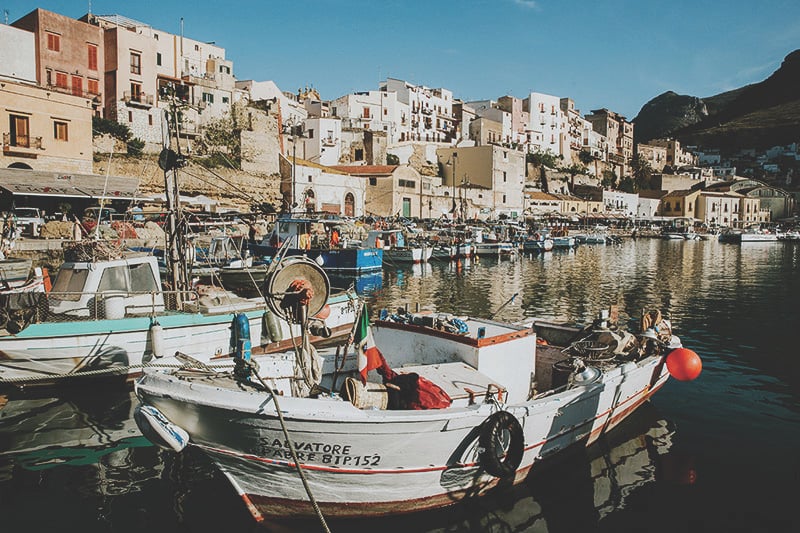I’m traveling to Sicily to find my grandfather. Although he died in 1929, his roots survive on this island at the end of a boot. For years, family members had urged me to discover the origins of our Sicilian heritage. “Just go,” one of my cousins had said shortly before his life ended unexpectedly. That was the shove I needed.
Discovery and travel are more than the final destination. In my case, my end was Castellammare del Golfo, a small harbor town in northwestern Sicily. However, to truly know my grandfather, I had to explore an entire country’s culture and traditions. My adventure began the moment I stepped from the train in Taormina, on the opposite coast, and hopped in my rental car.
Taormina is one of the most visited towns in Sicily, and its old-world charm has been the allure for those, like Oscar Wilde, who have made the steep climb into this ancient city. With little time to spend, I search for iconic emblems: the Fountain Piazza Duomo, the Cathedral of Taormina and the San Domenico, a Dominican monastery turned luxury hotel. I ditch my car for the Corso Umberto and walk the streets stacked with tiny shops and eateries, a welcome introduction to the slow-paced Italian lifestyle.
From the luxury of Taormina to the bustling industrialization of Catania, the southern drive along the Ionian Sea
provides breathtaking views of Mount Etna rising from the clouds. An active volcano that last erupted in December of last year, Mount Etna, a UNESCO World Heritage site, is one of the island’s most beautiful natural attractions and a playground for hikers.
Then, a brief stop in Catania at another UNESCO site. Highlighted by the ornate Cattedrale di Sant’Agata, the Piazza del Duomo is surrounded by crowds of people taking photographs, dining in outdoor cafes and splashing in the Fontana dell’Elefante, said to have magical powers. It is midday and maneuvering around Catania by car or on foot is problematic, so I order an arancini from a street vendor and enjoy the view.

This is my first introduction to street food in Sicily, and I discover that what is easy, compact and convenient is the way of life. The arancini (a deep-fried rice ball stuffed with meat or vegetables) satisfies my taste for authentic cuisine. Each city observes its own culinary rituals. Much like everything in Sicily, it’s all about tradition.
South of Catania is Siracusa, a UNESCO site. Siracusa was established by Greek colonists in the eighth century B.C. and was one of the largest cities in the ancient world. Thousands of years of history can easily be seen in the city’s center, the island of Ortygia, which is Siracusa’s loveliest part. From the Piazza Duomo to the ruins of the Temple of Apollo to the Fontana di Diana rising high in Piazza Archimede, this city embodies Sicily’s history.
I leave the East and travel southwest, leaving my coastal route and heading inland toward Agrigento. Although Agrigento feels like Catania in its presentation, what appeals to me most is not the city itself but the nearby Valley of the Temples, another UNESCO site that is home to some of the most well-preserved Greek ruins in the world. Rising high above the sea, this park consists of eight temples, some built as early as 510 B.C., that tell the story of a history that began with the founding of the Greek colony Akragas. Most impressive are the Temple of Concordia, a Doric temple that is almost completely intact, and the Temple of Hera, erected on the city’s southern hill as a warning to invaders. I pull out my hiking books and spend the day walking through history.
My final destination at hand, I travel the remainder of my route through Italian countrysides, taking in fields of red flowers and villas perched on hillsides. Unlike in America, rest stops do not come frequently, if they come at all. I happen upon a Coffee and Go, which is much like QuikTrip. Inside, two Frenchman huddle at a round table, sipping their coffees, laughing. At the counter, travelers order cappuccinos and espressos, which come quickly in dainty white porcelain cups and saucers.
Approaching Castellammare del Golfo, it feels like home. Possibly this is because of my prior research and conversations, which had painted scenes of narrow cobblestone streets, of fishermen prepping boats and nets for the day’s journey, of gentlemen chatting on park benches, of couples sharing wine and cannoli’s underneath a cafe umbrella, of children jetting in and out of shops without worry, and of meals and conversation hanging on long after midnight. It is all as I had imagined.
After only a brief and rapid glimpse of Sicily, my week’s adventure had opened doors to future travel and family. This journey was, as all travel should be, an exercise in pushing boundaries, taking risks, and discovering new places that inspire.
